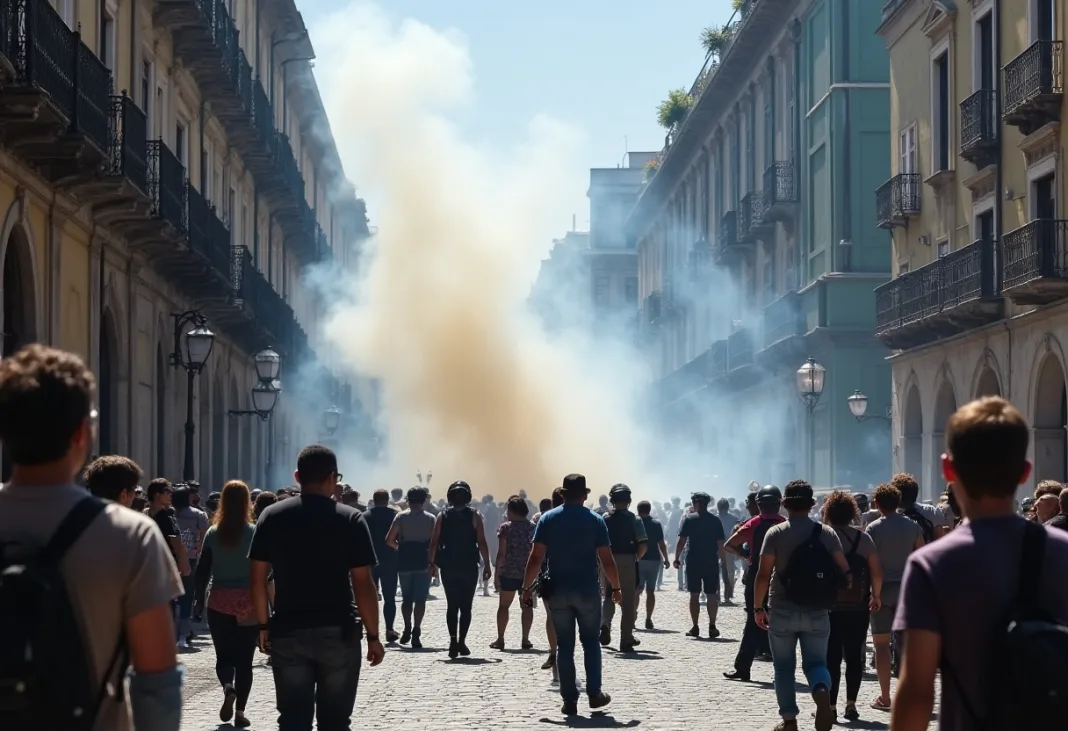Friday, July 25, 2025

What was initially intended as a peaceful protest in Mexico City quickly devolved into a scene of violence and chaos, as demonstrators took to the streets to voice their concerns over the effects of gentrification and the rapid surge in mass tourism. While the protest began with the promise of a peaceful gathering to address these issues, the situation escalated and soon became a full-blown riot, affecting both local residents and tourists alike.
The Backdrop: Growing Discontent Over Gentrification and Tourism
Mexico City has long been a popular destination for travelers, drawn by its rich culture, vibrant neighborhoods, and world-renowned culinary scene. However, as the city has become increasingly popular among foreign visitors, there has been growing concern about the impact this tourism is having on local communities. The protest was sparked by these concerns, particularly the displacement of long-time residents due to rising costs and the transformation of once-affordable neighborhoods into upscale, tourist-friendly areas.
The protest was organized by a group of locals who felt that their communities were being overrun by tourism, contributing to gentrification and a loss of cultural identity. While they acknowledged that tourism brought economic benefits, they argued that it was also eroding the essence of their neighborhoods and driving up the cost of living to unsustainable levels.
The Peaceful Protest Turns Violent
Initially, the protest was billed as a peaceful demonstration aimed at calling attention to the negative effects of gentrification. Hundreds of people gathered in the popular neighborhoods of Condesa and Roma, two areas well-known for their bustling cafes, restaurants, and cultural landmarks. However, the protest quickly spiraled out of control as masked protesters turned violent.
Eyewitnesses described scenes of chaos, with protesters vandalizing businesses, shattering windows, and looting upscale stores. The violence was shocking, especially for tourists who had come to enjoy the charm of these areas. One local who witnessed the events described the situation as “scary,” noting that they had never seen anything like it before. The protesters, many of whom were masked, left behind messages of anger and resentment scrawled across shattered storefronts. Graffiti such as “Get out of Mexico” and “Gringos, stop stealing our home” became rallying cries for the most radical demonstrators.
Tourists Caught in the Crossfire
For many tourists visiting Mexico City, the protest was an unexpected and unsettling experience. As the chaos unfolded, tourists found themselves trapped in the middle of the violence, with no clear way to escape. Several visitors reported feeling confused, frightened, and unsure of how to react as they were confronted by hostile protesters. Some were even harassed and shouted at, further adding to the fear and confusion. The atmosphere in the streets of Condesa and Roma became tense, as the peaceful surroundings turned into scenes of destruction.
This incident raises important questions about how protests like these can affect tourism and the city’s reputation as a welcoming destination for international visitors. As protests and violence unfold in popular tourist districts, the risk is that such events may deter potential visitors from coming to Mexico City in the future. Social media reactions from impacted tourists quickly went viral, with many expressing shock and disappointment over the violence. One tourist tweeted, “This is not what Mexico City is about. If this continues, who will want to visit?”
The Root Causes: Gentrification and Unchecked Tourism
The violence that erupted in Condesa and Roma was rooted in a much deeper issue—gentrification and the unchecked growth of tourism. In recent years, Mexico City has seen a surge in visitors, with millions flocking to the city each year to experience its vibrant culture, history, and modern amenities. While tourism has brought substantial economic benefits to the city, it has also led to rising rents, higher living costs, and the displacement of local residents who can no longer afford to live in neighborhoods that have become increasingly commercialized.
Diana Reyes, a spokesperson for the protest organizers, made it clear that the group was not opposed to tourism itself. Rather, their concerns centered around the need for regulations that could help manage the growing influx of visitors. The demonstrators argued that without local legislation to regulate the volume of tourists and control the pace of gentrification, their communities would continue to be overwhelmed, leaving long-time residents feeling alienated in the city they once called home.
Reyes stated, “We want to preserve our neighborhoods and maintain our cultural identity. We are not against tourism itself, but we believe there needs to be local legislation to better regulate tourism levels. Our communities cannot sustain this relentless growth.”
Social Media Amplifies the Outrage
As videos of the riots spread across social media, outrage quickly grew. Many users expressed their disbelief at how the protest had devolved into such violence. The images of shattered windows, looted stores, and angry protesters quickly went viral, further amplifying the tension surrounding the issue. Videos of the unrest showed the chaotic scenes unfolding in real time, and many commenters voiced their concerns about the potential consequences for the city’s tourism industry. The viral nature of the videos and the immediate public outcry raised alarms about the effectiveness of local law enforcement in managing large demonstrations, especially in such a rapidly urbanizing environment.
Several social media posts pointed to the failures of law enforcement in handling the situation. With such a large crowd and rising tensions, local authorities struggled to maintain order. In response to the violence, law enforcement officials ramped up their presence, but the situation continued to escalate before they could regain control. Police officers indicated that their primary goal was to ensure the safety of everyone involved, including tourists who were caught in the crossfire.
The Economic Aftermath: Impact on Local Businesses
The violence of the protest left many local businesses in the affected areas reeling. Many of these businesses had only just started to recover from the financial strain caused by the COVID-19 pandemic and the ensuing shutdowns. For small business owners in Condesa and Roma, the destruction was a devastating blow. Local entrepreneurs, such as café owners, expressed frustration over the damage and the toll it had taken on their ability to operate.
One local café owner, speaking after the event, lamented, “We are part of this city too. We support the cause but not this kind of violence. And we just want to serve our customers and live peacefully.” The protest, which was originally meant to raise awareness of the negative effects of tourism, inadvertently caused harm to the very businesses that many of the demonstrators hoped to protect. The damage to local shops, restaurants, and cultural landmarks will have long-term economic consequences for the affected areas.
Political and Social Repercussions
In the aftermath of the protest, city officials are under increased pressure to address the concerns of residents and tourists alike. Some urban analysts have raised concerns that unless effective measures are implemented to regulate tourism and control the pace of gentrification, protests like this could become more frequent—and even escalate further. Julian Torres, an urban studies professor, referred to the incident as a “wake-up call” for Mexico City’s government. He emphasized that without proactive steps to balance the interests of residents and tourists, the city could face more conflict in the future.
The challenge for city officials now is to find a way to accommodate the growing influx of tourists while ensuring that local residents are not displaced or pushed out of their own neighborhoods. This delicate balancing act will require thoughtful policy decisions, urban planning strategies, and a more inclusive approach to tourism development that takes into account the needs of both locals and visitors.
Looking Ahead: Can Mexico City Find a Sustainable Solution?
The events in Condesa and Roma have highlighted the deep tensions surrounding gentrification and tourism in Mexico City. As the city continues to grow and attract more visitors, the challenge of managing this growth in a way that benefits both residents and tourists will only intensify. The violent turn the protest took serves as a stark reminder of the need for more sustainable, community-focused tourism policies that prioritize the preservation of local cultures and neighborhoods.
As the situation continues to unfold, it is clear that Mexico City must find a way to address the concerns of its residents while still promoting tourism as a key driver of its economy. This will require a collaborative effort from all stakeholders, including local government, businesses, and residents, to ensure that the city’s cultural identity is preserved and its communities remain vibrant and livable for all.
Conclusion: A City at a Crossroads
Mexico City is at a crossroads, grappling with the complex issues of gentrification, tourism, and social inequality. The violent protest in Condesa and Roma serves as a poignant reminder of the growing tensions between residents and tourists. As the city looks to the future, the need for a more balanced and sustainable approach to tourism is more urgent than ever. By listening to the voices of the community and implementing thoughtful, effective policies, Mexico City has the potential to navigate this challenge and emerge as a model of inclusive and responsible tourism development.






